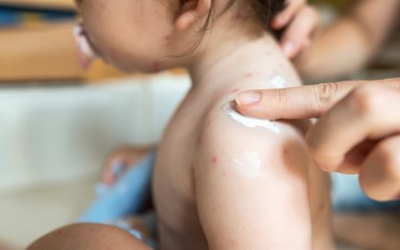Rashes in children are quite common. The skin of the children is quite sensitive as they are still developing with time and age. Most of the time rashes tend to be harmless and the need for treatment does not occur. It is recommended to see a doctor if the rash looks unwell and keeps spreading.
This article brings to you the most common causes of rashes that you will find in children.
Table of Contents
- Common Skin Rashes in Children
- 1. Cellulitis
- 2. Chickenpox
- 3. Eczema
- 4. Erythema Multiforme
- 5. Hand, Foot and Mouth disease
- 6. Impetigo
- 7. Keratosis Pilaris (“chicken skin”)
- 8. Measles
- 9. Molluscum Contagiosum
- 10. Pityriasis Rosea
- 11. Heat Rash
- 12. Psoriasis
- 13. Ringworm
- 14. Scabies
- 15. Scarlet Fever
- 16. Slapped cheek syndrome (fifth disease)
- 17. Urticaria (hives)
Common Skin Rashes in Children
1. Cellulitis
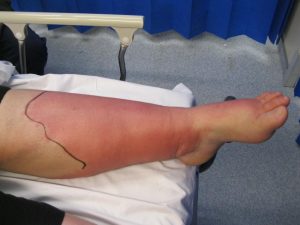
Cellulitis is a disease of the more profound layers of skin and underlying tissue. The affected zone will be red, hot, agonizing, and swollen. It frequently occurs on the legs, however, it can happen on any body part. Your kid will likely additionally have a fever. See your GP quickly if a zone of your kid’s skin out of nowhere turns red, hot, and delicate. In the event that you can’t see your GP around the same time, go to a stroll in focus or minor wounds unit. Cellulitis can ordinarily be analyzed by evaluating the symptoms and looking at the skin. It generally reacts well to treatment with anti-microbials.
2. Chickenpox
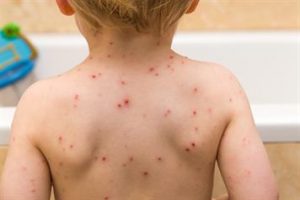
Chickenpox is known as a viral illness that the majority of the kids get eventually. It most generally influences kids under 10 years old. A rash of bothersome spots transforms into liquid-filled blisters. They crust over to frame scabs, which inevitably drop off. A few kids just have a couple of spots, though others have them over their whole body. The spots are well on the way to show up on the face, scalp, and ears, under the arms, on the belly and chest, as well as on the arms and legs.
There’s no particular treatment for chickenpox, however, you can find a way to diminish the indications. For instance, paracetamol can help alleviate fever (don’t offer aspirin to kids under 16), and calamine lotion and also cooling gels can be utilized to help with the itching.
3. Eczema

Eczema is a long-duration condition that makes the skin bothersome, red, dry, and split. The most well-known sort is atopic eczema, which essentially influences kids yet can proceed into adulthood.
Atopic eczema normally creates behind the knees or on the elbows, eyes, neck, and ears. It is anything but a genuine condition, however,r on the off chance that your youngster later gets contaminated with the herpes simplex infection, it can make the eczema erupt into an episode of small blisters called eczema herpeticum, and probably cause a fever. Around one out of five kids in the UK has eczema, and in eight out of 10 cases it creates before the age of five, frequently before a youngster’s first birthday celebration.
4. Erythema Multiforme
 Erythema multiforme is a gentle skin rash that is brought about by an unfavorably susceptible response to the herpes simplex infection. The spots seem like targets, along with a dull red center as well as a paler ring around the outside. The hands or feet will in general be influenced first, trailed by the limbs, chests are, and face.
Erythema multiforme is a gentle skin rash that is brought about by an unfavorably susceptible response to the herpes simplex infection. The spots seem like targets, along with a dull red center as well as a paler ring around the outside. The hands or feet will in general be influenced first, trailed by the limbs, chests are, and face.
Your kid will most likely feel unwell and possibly have a fever, which you ought to have the option to treat with over-the-counter medication. It might take from two to about a month and a half before they feel much good.
In uncommon cases, erythema multiforme can be activated by a response to specific prescriptions, for example, an antibiotic or anticonvulsant. This increasingly extreme structure is called Stevens-Johnson disorder and it very well may be dangerous.
5. Hand, Foot and Mouth disease
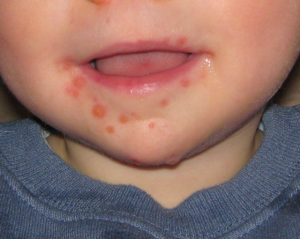
Hand, foot,t, and mouth sickness is a typical, infectious disease that causes mouth ulcers and blisters and spots on areas like the palms of the hands and bottoms of the feet. It’s generally normal in little youngsters (especially those below 10 years), however,r it can likewise influence more established kids and grown-ups.
There’s no remedy for hand, foot,t, and mouth illness and it’s handily spread, so you should get your kid far from school or nursery until they feel better. Your kid’s immune system will battle the infection and it should be over after around seven to 10 days.
Ensure your youngster drinks a lot of liquid, and if eating and gulping is uncomfortable, give them delicate nourishments, for example, mashed potatoes, yogurt,t, and soup.
6. Impetigo
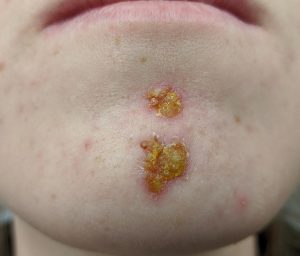
Impetigo is a typical and exceptionally infectious skin contamination that causes wounds and blisters. It isn’t typically genuine and frequently improves inside seven days of treatment. There are two sorts of impetigo – bullous and non-bullous.
Bullous impetigo normally influences the storage compartment (the region of the body between the abdomen and neck, and causes liquid-filled blisters that burst following a couple of days to leave a yellow outside crust. Non-bullous impetigo ordinarily influences the skin near the nose and mouth, causing injuries that immediately burst to leave a yellow-earthy colored crust.
See your GP on the off chance that you think your kid has impetigo. Antibiotics agents, as a cream or tablets, will be recommended. This ought to decrease the length of the disease to around seven to 10 days.
7. Keratosis Pilaris (“chicken skin”)
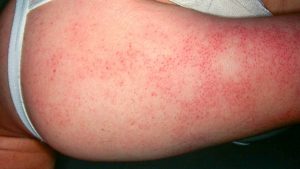
Keratosis pilaris is a typical and innocuous skin condition. The skin on the rear of the upper arms turns out to be unpleasant and uneven, as though covered in permanent goose bumps in pimple form. Once in a while, the butt, thighs, lower arms, and upper back can likewise be influenced. Keratosis pilaris ordinarily starts in a period of childhood and deteriorates during pubescence. A few people discover it improves after this and may even vanish in adulthood.
There’s no solution for keratosis pilaris, and it regularly shows signs of improvement all alone without treatment. Nonetheless, there are a few estimates you can apply that may improve your kid’s rash, for example, utilizing non-cleanser chemicals as opposed to soap, and an emollient to saturate their skin. Your GP or drug specialist will have the option to suggest an appropriate cream.
8. Measles
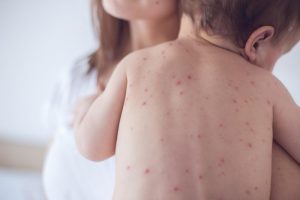
Measles is an exceptionally infectious disease that most ordinarily influence little youngsters. It’s presently uncommon in the UK as a result of the viability of the measles, mumps, and rubella (MMR) immunization. The measles rash obtains red-brown blotches. It for the most part begins the head or upper neck and afterward spreads outwards to the remainder of the body. Your kid may likewise have a fever and cold-like side effects.
Call for GP surgery quickly on the off chance that you think your kid has measles. It’s ideal to telephone before visiting in light of the fact that the medical procedure may need to make courses of action to decrease the danger of spreading the disease to other people. Measles normally goes in around seven to 10 days without bringing about additional issues. Paracetamol or ibuprofen can be utilized to soothe a fever, throbbing pain, and ache (don’t offer aspirin to kids below 16 years). Likewise, ensure your kid drinks a lot of water to maintain a strategic distance from lack of hydration.
9. Molluscum Contagiosum
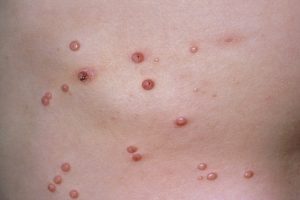
Molluscum contagiosum is a viral skin disease that causes groups of little, firm, raised spots to create on the skin. It normally influences small kids matured one to five years, who will in general catch it after close physical contact with another contaminated kid. The condition is normally painless, albeit a few of the kids may encounter some irritation. It for the most part leaves inside a year and a half without the requirement for treatment.
Molluscum contagiosum is extremely infectious. Be that as it may, most grown-ups have resistant power to the infection, which means they’re probably not going to get it in the event that they come into contact with it.
10. Pityriasis Rosea
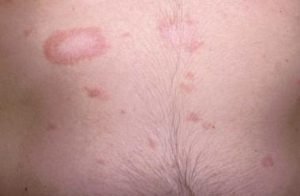
Pityriasis rosea is a generally normal skin condition that causes a transitory rash of raised, red scaly patches to create on the body. Most cases happen in more older kids and youthful grown-ups (matured somewhere in the range of 10 and 35).
The rash can be extremely irritating. As a rule, it clears up in 2 to 12 weeks without the need for treatment, in spite of the fact that in uncommon cases it can last as long as five months. Emollients, antihistamines, and steroid creams can be utilized to help diminish the irritation. The rash doesn’t leave scars, despite the fact that the skin can at times be stained a while later.
11. Heat Rash
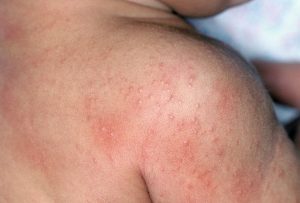
Heat rash (prickly heat), otherwise called miliaria, is an irritating rash of little, raised red spots that form a stinging or thorny sensation on the skin. It happens when the sweat ducts in the external layer of skin (epidermis) are impeded. You can get a heat rash anyplace on your body, yet the face, neck, chest, back, or thighs are frequently influenced.
Newborn children can some of the time get a thorny heat rash on the off chance that they sweat more than expected – for instance when it’s hot and humid or on the off chance that they are dressed too much. It is anything but a genuine condition and once in a while requires a particular treatment.
12. Psoriasis
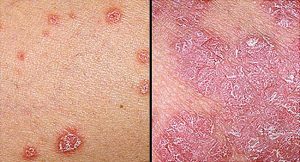
Psoriasis is an enduring (ceaseless) skin condition that causes red, flaky, patches of skin that is covered with silvery scales. The seriousness of psoriasis fluctuates significantly from individual to individual. For certain individuals, it’s only a minor disturbance, however, for other people, it can majorly affect their personal life. There’s no solution for psoriasis, however, there are various medicines that can help improve the side effects and presence of skin patches. For instance, topical corticosteroids are creams and treatments that can be applied directly to the skin.
13. Ringworm
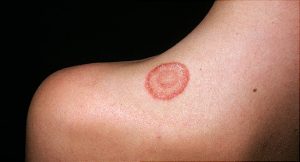
Ringworm is an exceptionally infectious contagious skin disease that causes a ring-like red or gleaming patch on the skin that can be scaly, aggravated, or irritable. Ringworm frequently influences the arms and legs, however, it can show up anyplace on the body. Other comparable parasitic diseases can influence the scalp, feet, crotch, and nails.
Ringworm can for the most part be effortlessly rewarded with antifungal medications, which are accessible from a drug store. Ringworm of the scalp can form scaling and patches of baldness. It can be medically treated with antifungal tablets, regularly joined with antifungal hair shampoo.
14. Scabies
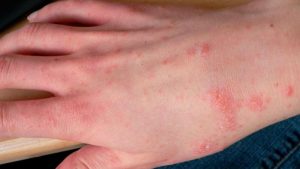
Scabies is an infectious skin condition that is seriously bothersome. It’s brought about by small mites that tunnel into the skin. Considering children, scabies is typically spread through delayed times of skin-to-skin contact with a contaminated grown-up or kid – for instance, during play battling or embracing. The mites like warm areas, for example, between the fingers, skin folds, under fingernails, or around the butt cheek creases. They leave little red blotches, which are regularly found on the palms of the hands or bottoms of the feet. In newborn children, blisters are generally found on the bottoms of the feet.
See your GP on the off chance that you think your kid has scabies. It’s not generally a genuine condition, yet it should be dealt with. Your GP will recommend a moisturizer or cream.
15. Scarlet Fever

Scarlet fever is an exceptionally infectious bacterial disease that typically influences kids somewhere in the range of two and eight years old. It causes a particular pink-red rash, that feels like sandpaper when you touch and might be itchy. It frequently begins with a sore throat, headache, and fever, with the rash creating two to five days after contamination. The rash ordinarily happens on the chest and stomach before spreading to different regions of the body, for example, the ears and neck.
Scarlet fever typically clears up after about seven days, however, visit your GP in the event that you figure your kid may have it. Anti-microbials are utilized to treat it (fluid antibiotics agents, for example, penicillin or amoxicillin, which are frequently used to treat kids).
16. Slapped cheek syndrome (fifth disease)
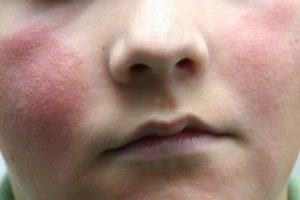
Slapped cheek syndrome – otherwise called fifth sickness or parvovirus B19 – is a viral contamination that is normal in kids matured 6 to 10 years. It makes an unmistakable splendid red rash to create on the two cheeks. This can look disturbing, however, it ordinarily clears up without any help in one to three weeks. Except if your kid is feeling unwell, they don’t have to avoid school. When the rash shows up, the contamination is not, at this point infectious. Be that as it may, it’s a smart thought to tell your kid’s school about the contamination.
17. Urticaria (hives)
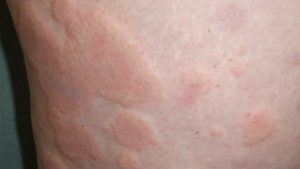
Urticaria – otherwise called welts, hives, weal, or nettle rash – is a raised, bothersome rash that can influence one piece of the body or be spread across enormous zones. It’s a typical skin response that frequently shows up in kids. Urticaria happens when a trigger causes higher levels of histamine and other substance detachments to be discharged in the skin. These substances help the blood vessels in the veins to open up, bringing about redness or pinkness, and irritation and swelling.
There are numerous potential triggers of urticaria, including allergens, for example, food or latex, aggravations, for example, nettles, medications, and physical variables, for example, warmth or exercise. Some of the time, a reason can’t be distinguished. The rash is typically fleeting and gentle, and can frequently be controlled with antihistamines.

